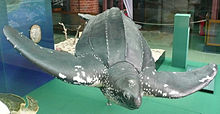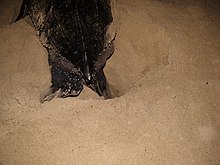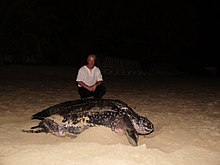Leatherback turtle
| Leatherback turtle | ||||||||||||
|---|---|---|---|---|---|---|---|---|---|---|---|---|

Leatherback turtle laying eggs |
||||||||||||
| Systematics | ||||||||||||
|
||||||||||||
| Scientific name of the family | ||||||||||||
| Dermochelyidae | ||||||||||||
| Fitzinger , 1843 | ||||||||||||
| Scientific name of the genus | ||||||||||||
| Dermochelys | ||||||||||||
| Blainville , 1816 | ||||||||||||
| Scientific name of the species | ||||||||||||
| Dermochelys coriacea | ||||||||||||
| ( Vandelli , 1761) |
The leatherback turtle ( Dermochelys coriacea ) is the largest living turtle and is mostly regarded as the only member of the family of the same name (Dermochelyidae). It is therefore not part of the family of sea turtles (Cheloniidae) zoologically , but is united with them in the superfamily Chelonioidea, which is sometimes also referred to in German as sea turtles . Their habitat are tropical and subtropical seas. So far no subspecies have been distinguished for this species.
description
The animals reach a shell length of up to 2.5 meters and a weight of almost 700 kilograms. The record is held by a leatherback turtle that was washed up on Harlech Beach in Wales with a carapace of 256 centimeters and a weight of 916 kilograms.
Analogous to the softshell turtles and unlike other turtles, the leatherback turtle does not have a typical back shield with horn scales. The loosely connected bone armor is rather surrounded by a tough leather-like skin. The carapace is elongated and tapers at the rear. Seven thickened bone platelets or longitudinal keels can clearly be seen on the blue-black back. There are five further longitudinal keels on the belly armor . The neck is relatively short and cannot be retracted into the shell. Your extremities are transformed into long paddles. They lack claws, which is very atypical for turtles. A skin membrane is also stretched between their hind legs and tail.
On top of the head, each leatherback turtle has a pink spot, the shape of which is individual. The function is unknown; it may be a light-sensitive patch of skin that is used for orientation.
As researchers found out, diving leatherback turtles first strike with powerful strokes of their swim fins in order to dive, penetrating about half a meter per second into the depth. After that, however, their swimming movements become more leisurely until the animals finally slide down further and further without effort. This is due to the fact that their lung volume decreases so much with increasing water depth that they have a greater specific weight overall than the surrounding water. They can cover up to 80 percent of their diving distance in this way. If their lungs collapse, they can only fall back on the oxygen reserves in their blood and muscles.
Occurrence
Leatherback turtles are ocean dwellers and are found in all tropical and subtropical seas. In summer they occasionally get into the temperate zones. This gives them the widest habitat of all reptiles. Due to their dark skin color, a layer of fat and their high mass, leatherback turtles can also live in cool water. They can keep their body temperature up to 18 degrees above that of the surrounding water. For example, leatherback turtles are seen relatively frequently off the coast of Scotland . Little is known about their migratory behavior. Two research projects in which the animals are given backpacks with transmitters have yielded results in both the Atlantic and the Pacific. It became known that some of the animals swim 5000 km from tropical to temperate waters in spring and return in autumn. In addition, nesting females are marked to find out whether they stay true to their nesting sites.
On September 5, 2006 , an empty shell of a leatherback turtle was washed up on the North Frisian island of Amrum . Lately (2009) isolated living specimens have been sighted off the coast of the Netherlands . So far, experts have been puzzling over how the animals got into the relatively cool North Sea . At the beginning of August 2012, a specimen weighing around 320 kilograms and 2 meters long was found near Salin-de-Giraud in the Camargue on the French Mediterranean coast. The animal had an identification tag from the Caribbean state of Trinidad and Tobago , so it had migrated around 7,000 km. In September 2014, a leatherback turtle about 180 cm - 200 cm long was observed and photographed in the Nusfjord in Lofoten (Norway). In August 2015, a leatherback turtle washed up on the Danish island of Langeland .

Reproduction
Leatherback turtles kept in captivity sometimes reach sexual maturity as early as two to three years of age. During mating, the male clasps the middle of the body of the female with his extremely long fins.
Although leatherback turtles are very well adapted to aquatic life, they need land to lay eggs. The nests are created on sandy coasts all over the world. There are about 64 nesting beaches known for this species:
- The nesting beaches on the coasts of the Atlantic are found in North America ( Florida ), the Caribbean and Central America ( Jamaica , Trinidad and Tobago , Nicaragua , Costa Rica , Guatemala ) and in South America ( Suriname , French Guiana ) and in Africa ( Gabon , west coast South Africa).
- The nesting beaches on the coasts of the Indian Ocean in Natal , Sri Lanka , India , Thailand , Malaysia , Australia and in the Pacific off Mexico .
The females swim to the beach at night and dig a hole in the sand in which they lay 50–100 eggs. After the hollow has been closed, the animals return to the sea and leave the incubation of the eggs to the warmth of the sun. The clutches are endangered by predators. In investigations in Sri Lanka and India, 59 percent of all eggs fell victim to wild boars and golden jackals . The incubation temperature has an influence on the sex of the hatching young animal. At temperatures between 27 and 28.7 degrees, mostly males hatch. At temperatures of 29.7 to 32 degrees Celsius, it is predominantly females who leave the eggs. At this point, they are between 5.8 and 6 centimeters tall.
The young animals hatching after about 55 to 56 days immediately seek the water. Little is known about the life to the adult tortoise or the age of sexual maturity. Mating and further life take place exclusively in the water. Only the females ever return to land.
nutrition
The leatherback turtle is an excellent diver. It reaches depths of up to 1200 meters.
The leatherback turtle's main food is jellyfish , the main occurrence of which is found in all of the world's oceans. The sharp horn edges of their jaws are helpful in grabbing the slippery food. A leatherback turtle needs between 10 and 100 kg of jellyfish per day.
Endangerment status
Like real sea turtles , leatherback turtles are endangered in their population, especially in the Pacific. The reasons for this are hunting, removing eggs from the nests for consumption and fishing. In Tamil Nadu , India, an oil is extracted from the tanks of this type, which is used on site to seal the wooden boats.
A much greater danger for leatherback turtles is fishing and the rubbish floating in the sea. The leatherback turtles get caught in nets and long lines and suffocate underwater due to a lack of air. Sometimes they mistake plastic bags for jellyfish floating in the water and eat them. This can be fatal to the turtles. The large amounts of garbage floating in the oceans in large garbage whirlpools are therefore one of the greatest dangers for this species. Studies have shown that 44 percent of the animals have plastic waste in their stomachs. The situation is less dramatic in the Atlantic.
In an IUCN report from December 2009 for the UN Climate Change Conference in Copenhagen it is assumed that the leatherback turtle is one of the animal species most threatened by global warming .
supporting documents
Individual evidence
- ↑ Wolfgang Böhme: Testudines (Chelonia), turtles. In: Wilfried Westheide, Reinhard Rieger (Ed.): Special Zoology. Part 2: vertebrates or skulls. Gustav Fischer Verlag, 2004, ISBN 3-8274-0900-4 , pp. 345-352.
- ↑ a b Indraneil Das: The Tortoises of the Indian Subcontinent , Edition Chimaira, Frankfurt am Main 2001, p. 38
- ^ Diemut Klärner: With collapsed lungs in depth. In: FAZ.net . September 9, 2011, accessed December 16, 2014 .
- ↑ Leather shield pad zwemt bij Texel ( Memento of the original from October 24, 2009 in the Internet Archive ) Info: The archive link has been inserted automatically and has not yet been checked. Please check the original and archive link according to the instructions and then remove this notice.
- ↑ A rare beach visitor: Caribbean giant turtle swims to the south of France. In: nzz.ch. August 7, 2012, accessed December 16, 2014 .
- ↑ Da padlerne kom nærmere, snudde de plustelig i frykt (Norwegian newspaper report with photo). In: nordlys.no. September 10, 2014, accessed July 5, 2015 .
- ↑ Sjælden læderskildpadde er skyllet på land i Danmark. Danish Broadcasting Corporation (Danmarks Radio), accessed August 12, 2015 .
- ↑ a b Indraneil Das: The Tortoises of the Indian Subcontinent , Edition Chimaira, Frankfurt am Main 2001, p. 39
- ↑ GC Hays, JD Houghton, AE Myers: Endangered species: Pan-Atlantic leatherback turtle movements. In: Nature. Volume 429, Number 6991, June 2004, p. 522, ISSN 1476-4687 . doi : 10.1038 / 429522a . PMID 15175742 .
- ↑ Indraneil Das: The Turtles of the Indian Subcontinent , Edition Chimaira, Frankfurt am Main 2001, p. 40
- ↑ Climate change: arctic fox and koala bear threatened. In: fr-online.de. December 14, 2009, accessed December 16, 2014 .
literature
- Indraneil Das: The turtles of the Indian subcontinent. Edition Chimaira, Frankfurt am Main 2001, ISBN 3-930612-35-6 .
Web links
- Dermochelys coriacea in The Reptile Database
- Turtle Trax
- Turtle Foundation
- Leatherback turtles in Nicaragua
- Migratory movement of leatherback turtles via satellite
- Great Turtle Race
- Dermochelys coriacea inthe IUCN 2013 Red List of Endangered Species . Posted by: BP Wallace, M. Tiwari & M. Girondot, 2013. Retrieved December 14, 2013.




